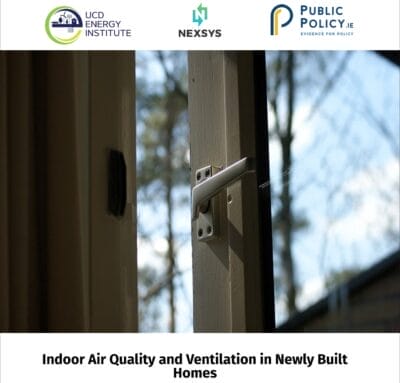
A new policy paper from NexSys, an all-island, multidisciplinary energy research programme, has highlighted that the current standards for ventilation in energy-efficient homes in Ireland do not always support healthy indoor air quality.
‘As part of Ireland’s commitment to a sustainable future, there is a big focus on building energy-efficient homes and promoting deep retrofitting of existing premises to increase their energy efficiency,’ says lead author Dr Divyanshu Sood, a Senior Energy Systems Researcher at the UCD Energy Institute.
‘Energy efficiency in buildings is important for sustainability, but we need to ensure that the air quality inside the house is both comfortable and healthy for the people in those buildings.’
Poor indoor air quality is associated with an increased risk of respiratory symptoms and potential cardiovascular problems, as defined by the World Health Organisation.
The NexSys policy paper draws from a study of nine energy-efficient homes in Ireland with natural ventilation. The study showed a buildup of carbon dioxide, volatile organic compounds and particulate matter in living rooms, kitchens and bedrooms as a consequence of people living and cooking in the houses without an adequate supply of air.
The paper makes policy recommendations to improve indoor air quality in energy-efficient homes, including allowing for mechanical ventilation and making occupants more aware of the need to open windows and doors and ventilate living areas.
‘While current building standards meet energy-efficiency requirements, they do not explicitly require indoor air quality to be considered in design. They assume compliant ventilation will dilute pollutants, and do not account for how occupants’ everyday activities can affect air quality,’ says Dr Sood.
‘The standards work on paper, but our study shows that once people move in and carry out everyday activities — such as cooking, burning scented candles, or using sprays — inadequate ventilation often has a negative impact on indoor air quality over time,’ says Dr Ibrahim.
The new policy paper summarises research conducted as part of the ALIVE project in the University of Galway and University College Dublin.
The ALIVE project tracked air quality, energy usage and user behaviour in nine houses that had been newly built and complied with energy standards, achieving A2 or A3 BER ratings. Each home was occupied by adults and children.
The new policy paper outlines several policy recommendations that are needed to address the potential impact of current energy-efficiency standards on indoor air quality.
They include changing how indoor air quality is monitored to ensure safety, combining natural and mechanical ventilation to improve air switching and indoor air quality, and house occupants being made aware of the importance of opening windows to improve indoor air quality.
“Opening a small window may noticeably affect indoor temperature, but it can greatly improve air quality. Our study found that when occupants recognise poor air quality and understand ventilation in airtight homes, they take timely actions that swiftly dilute built-up pollutants, as shown by several ‘shining example’ houses”, says Dr Ibrahim.
“Summer overheating is another significant challenge highlighted by our study, where factors such as inadequate ventilation, poor building orientation, and limited shading can increase the risk of indoor overheating”, says Dr Sood.
’This is an opportunity to improve the health and living standards of people living and working in energy-efficient buildings,’ says Dr Sood.
In the meantime, Dr Sood suggests that people living in energy-efficient homes can improve indoor air quality by opening windows to bring fresh air in.
The policy paper, Indoor Air Quality and Ventilation in Newly Built Homes, is available from NexSys and on PublicPolicy.ie
